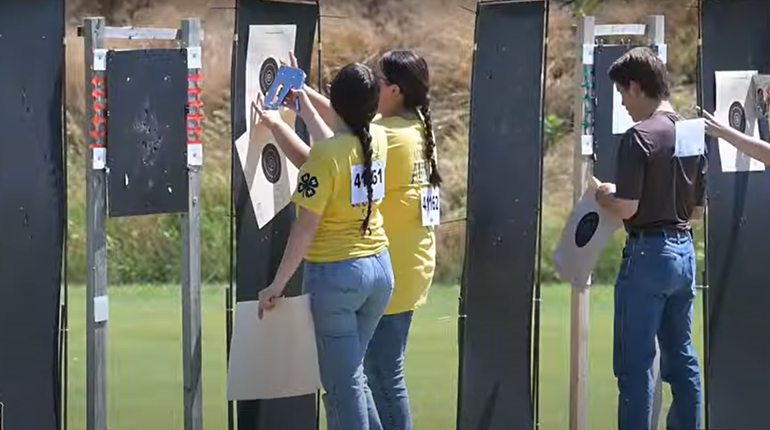
Let’s take a break from the serious subject of defense and consider shooting for fun (though fun has a very useful defense component). Bowling pin shooting used to be quite the activity, but it went through a nearly two-decade hiatus, meaning there is a whole generation of shooters who aren’t familiar with it. As of last year, though, pin shooting is back. For those who missed out of its last run with popularity and therefore need to learn about it, the essence is simple;
You place an array of pins on a steel-topped table (wooden tables don’t last long) with the pins 26 feet away from you. On the start signal, shoot the pins off the table as fast as you can. Fastest shooter wins. The competitive purity of the event is this: there are no scoring rings, no arguments over power or caliber, no alibis—just you and the pins. There are equipment restrictions, but they are minimal, and a good “pin gun” is easy to come by.
But the essence of pin shooting is that it let you get acquainted with the notion of Power Factor. In practical competition, you have to meet or exceed a certain threshold of power to be scored Major or Minor. For Major, that Power Factor is 165. Power Factor is determined by multiplying the bullet weight (in grains) by velocity in feet per second; then, you drop the last three digits. So, a .45 ACP, firing a 200-grain bullet at 825 f.p.s. (200 x 825 = 165,000), exactly meets the 165 Power Factor threshold. The Minor threshold is generally 125, depending on the competition. That means you need a 125-grain, 9 mm bullet at 1,000 f.p.s. Every major match has an elaborate process to chronograph competitors’ ammunition in order to ensure they are shooting what they say they are shooting. In a pin match, the pins do that.
How much is enough for pins? The collective experience of pin shooters through the years is that you need a minimum of a 195 Power Factor to reliably push a pin off the table. That makes pin shooting, at least in the Main Event (some of the Optionals differ; keep reading to learn more about those), the province of serious calibers. If you believe the idea that “handgun calibers begin with the numeral 4,” then pin shooting should be in your match schedule.
Keep in mind, though, that it can be possible to have too much of a good thing. Because your score is determined by the amount of time it takes to shoot the pins off the table, shooting a .44 Mag., with a 240-grain bullet at 1,200 fps (288 Power Factor) is going to slow you down considerably. So, almost all serious pin shooters reload their ammunition, and they aim for a Power Factor in the 195 to 210 range, which is easy for some calibers, tough for others, and impossible for some really popular ones.
One of the impossible ones is 9 mm. You simply aren’t going to be able to achieve a 195 PF with a 9 mm, a 9x23 mm, a .38 Super or any other medium-bore pistol cartridge. That’s why there are Optional events, events that require that you only tip over the pins, not clear them from the tabletop.
The .40 S&W is marginal, when it comes to attaining a high Power Factor. On paper, you can just make a 195, but the experience of watching shooters with “hot” 40 loads over the years has been one of disappointment. The 10 mm is just fine, as it has the capacity for enough extra weight, speed or both, to cross the 195 Power Factor line.
The .45 is a fan favorite, because here all it takes is an upper-end or +P .45 load. A 230-grain bullet needs only 848 fps to hit a 195 Power Factor, and that is easy. Going up to 900 f.p.s. gets you a 207 Power Factor, and there are plenty of factory +P loads that deliver that.
Revolver shooters will find loading up pin loads easy. You cannot do it in a .38 Spl., end of story. However, a .357 has no problem. A 158-grain bullet needs 1,235 f.p.s., and you can easily do that out of a 6- inch or 8-inch revolver. A heavier 180-grain bullet needs only 1,084 f.p.s. Everything bigger in bore is even easier to load up, so the .41 Mag., .44 Spl., .44 Mag., .45 ACP and .45 Colt all find favor for pin shooting in the hands of wheelgunners.
The last consideration is bullet shape. Hollowpoints and flat-point shapes such as semi-wadcutters or even wadcutters, are the best bets. A center-punched pin will clear a table regardless of bullet shape, but pins are curved. An off-center hit calls for something that will bite into the pin, rather than glancing off. Pin shooters don’t need to care if the bullet expands.
What is the defensive component to all this? Well, you are using a serious caliber, under the stress of competition, shooting at a relatively small target. Shooting a .45 ACP+P load in a match is good practice for dealing with recoil, regardless of what you may use in your every-day-carry gun. The “sweet spot” on a bowling pin is about the size of a playing card, not an easy target, even at 26 feet. And you are doing this against the clock, with everyone else watching. That’s stress.
Pin shooting fulfills all components of the classic equation of speed, power and accuracy. It does so with the stress of competition. If you see a notice at your gun club about a pin shoot someplace, do yourself a favor and give it a try. You’ll be a better shooter for it, and you’ll likely have fun while you’re getting better.


































